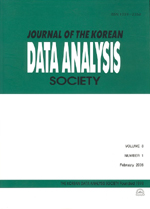수리 가능한 시스템의 수명과 고장횟수의 모형화를 위한 이질적 환경효과
Heterogeneous Environment Effects for Joint Modeling of Death Times and Number of Failures in Repairable Systems
- 한국자료분석학회
- Journal of The Korean Data Analysis Society (JKDAS)
- Vol.3 No.2
-
2001.06163 - 178 (16 pages)
- 이용수 2

키워드
초록
본 논문에서는 이질적인 환경효과를 고려한 수리 가능한 시스템의 수명과 고장발생횟수간의 결합모형을 개발하여 모형의 구조와 특성을 파악하고, 모형에 포함된 모수의 추론과정을 살펴보고자 한다. 시스템의 수명과 고장발생횟수의 각각에 영향을 미치는 환경효과들을 나타내는 분포를 감마분포로 가정하고, 시스템의 수명은 와이블분포를 가정하였으며, 고장발생횟수는 포아송분포를 따르는 것으로 가정하였다. 개발된 모형을 모의실험을 통해 얻어진 자료에 적용하는 동시에 환경효과를 고려한 모형과 이를 고려하지 않은 독립모형과의 비교를 통하여 환경효과의 영향을 고찰하였다. 또한 개발된 모형의 특성을 파악하기 위해 시스템의 수명과 고장발생횟수의 변화에 다른 여러 가지 확률의 변화하는 양상을 고찰하였다.
In this paper we consider the problem of modeling count data where the observation period is determined by the life time of the repairable system under heterogeneous frailty. And we show the structure of individual frailty models. We assume frailty models to allow for unobservable environment effects. We assume that, given a random effect or a frailty, the death times follow a Weibull distribution with a hazard rate. For the counts, given a frailty, a Poisson process is assumed with the intensity depending on time. A gamma distribution is assumed for the frailty model. Maximum likelihood estimators of the model parameters are obtained. A model for the time to death and the number of failures system received is constructed and consequences of the model are examined.
목차
1. 서론
2. 모형의 개발 및 모형의 성질
3. 모수의 추정
4. 예제
5. 결론
참고문헌
참고문헌 (0)
등록된 참고문헌 정보가 없습니다.
해당 권호 수록 논문 (0)
등록된 수록 논문 정보가 없습니다.